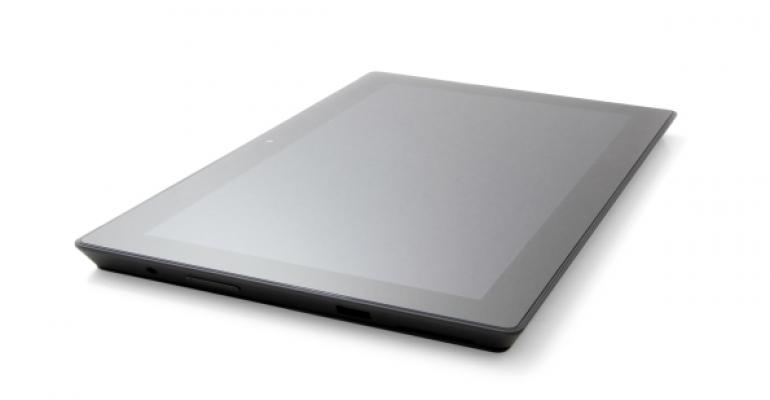Microsoft's recent announcement of the Surface shows that the company has every intention of moving into the tablet market that formerly was the near-exclusive domain of the Apple iPad. I still remember those Steve Ballmer presentations where he expressed disdain for both the iPhone and the iPad, but nowadays, following the success of both of those devices, Microsoft has obviously reconsidered its position and decided to jump feet first into the phone and tablet markets. Unlike the strategy with the marginally successful Windows Phone, Microsoft has decided that it will compete with its own tablet device rather than relying on partners to bring the Surface to market. When you add up this news with the entry of Google's new Nexus 7, there's no doubt the tablet market will be a hot spot for 2013. Let's take a look at the top 10 frequently asked questions about the pending Surface.

Microsoft Surface Tablet
1. What's the Surface form factor, and how does it compare to the iPad?
There are actually two versions of the Surface and they're slightly different. Both versions provide a 10.6" HD touch screen. The Windows RT version of the Surface tablet is slightly smaller, measuring 0.366" thick and weighing 1.5 pounds. The Windows 8 version is 0.52" thick and weighs 2 pounds. These specs are similar to the new iPad, which has a 9.7" 2048 × 1536 display and is 7.31" wide by 0.37" thick. The iPad weighs in at 1.44 pounds.
2. What makes the Surface different from the iPad?
There's no doubt Microsoft has put some real thought into the Surface design. It comes with a convenient built-in kickstand. The Surface tablet also features a unique 3mm magnetically attached cover that uses pressure-sensitive technology to double as a keyboard and mouse. Early reports say that the initial release of the Surface will have only WiFi connectivity and will lack the 3G/4G capabilities found in the new iPads.
3. What processor does the Surface use?
The different Surface models will come with different processors. NVIDIA made public that the Windows RT Surface will use the NVIDIA Tegra ARM processor. This processor will probably be the Tegra 3, a 1.4GHz quad-core processor. The Windows 8 version is currently expected to use an Intel i5 CPU. The Intel i5 is used in many of today's ultrabooks—it's dual-core and runs at up to 2.7GHz. In comparison, the iPad uses a 1GHz dual-core Apple A5 processor that's manufactured by Samsung.
4. What sort of storage and connectivity options does the Surface have?
The Windows RT version will be available in 32GB and 64GB. Connectivity options include Micro HD Video, microSD, USB 2.0, and twin 2 × 2 MIMO antennas for WiFi. The Windows 8 version will come in 64GB and 128GB and will have a microSDXC, USB 3.0, Mini DisplayPort Video, and 2 × 2 MIMO antennae.
5. Is the Surface compatible with Windows 7 applications?
The answer is no and yes, depending on the version of the Surface. Don't expect Windows RT to work with traditional Windows 7 and Windows XP apps. The ARM processor won't run x86 applications. The x86-based Windows 8 version will run existing Windows 7 and XP apps.
6. Will Microsoft Office run on the Surface?
Office integration will be a key to the success of the Surface, and it will be a key differentiator between the Surface and the iPad or Google’s Nexus 7. The Windows RT and Windows 8 versions of the Surface will run different versions of the Microsoft Office productivity suite. Microsoft has stated that the basic Office Home & Student 2012 RT version will be included in the Windows RT version. This Office version includes Word, Excel, PowerPoint, and OneNote. Microsoft hasn't stated if Office will be included with the Windows 8 version, but it can run previous versions of the Office suite.
7. What are some of the differences between the Windows RT and Windows 8 Surface models?
The biggest difference is in the application support or lack of x86 application support in the Windows RT version. However, the Windows RT version will be thinner and lighter, weighing in at a mere 1.5 pounds compared to 2 pounds for the Windows 8 version. The Windows 8 version will also provide 1020p screen resolution, exceeding the Windows RT version's 720p resolution.
8. Will Microsoft be the only maker of the Surface?
Yes and no. Surface is a Microsoft brand, and only Microsoft will market that brand. However, other companies are sure to release similar tablets.
9. What's the price of the Surface?
At this point, Microsoft hasn't provided specific pricing for the Surface. However, it's clear that the Windows RT version and the Windows 8 version will have different audiences and hence different price points. The Windows RT version is targeted toward consumers and will presumably have a price point that's competitive with the iPad, which starts at $499. The Windows 8 version is targeted toward business professionals and will probably be priced closer to today's ultrabooks.
10. When is the Surface supposed to be available?
Microsoft has stated that it expects the consumer-oriented Windows RT version of the Surface to be available October 26, 2012. The Windows 8 version is expected a few months later, probably in the first quarter of 2013.





